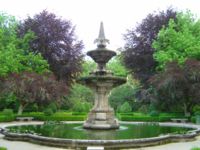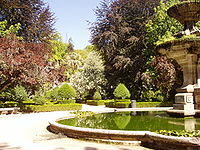
Botanical Garden of the University of Coimbra
Encyclopedia




The Botanical Garden of the University of Coimbra (Jardim Botânico da Universidade de Coimbra or simply Jardim Botânico) is a botanical garden
Botanical garden
A botanical garden The terms botanic and botanical, and garden or gardens are used more-or-less interchangeably, although the word botanic is generally reserved for the earlier, more traditional gardens. is a well-tended area displaying a wide range of plants labelled with their botanical names...
in Coimbra
Coimbra
Coimbra is a city in the municipality of Coimbra in Portugal. Although it served as the nation's capital during the High Middle Ages, it is better-known for its university, the University of Coimbra, which is one of the oldest in Europe and the oldest academic institution in the...
, Portugal
Portugal
Portugal , officially the Portuguese Republic is a country situated in southwestern Europe on the Iberian Peninsula. Portugal is the westernmost country of Europe, and is bordered by the Atlantic Ocean to the West and South and by Spain to the North and East. The Atlantic archipelagos of the...
. It was founded in 1772-1774 and it was integrated in the Natural History Museum established by the Marquis of Pombal. The place for the Hortus Botanicus was chosen by the vice-chancellor of the University of Coimbra (Francisco de Lemos) and it was part of the farm of S. Bento's College, located at the Ursulinas Valley. Domingos Vandelli was the first supervisor for the orientation of the Garden, being followed in 1791 by Félix Avelar Brotero
Félix Avelar Brotero
Félix Avellar Brotero was a Portuguese botanist and professor. He fled to France in 1788 to escape persecution by the Inquisition, and there published his Compendio de Botanica in order to earn his living...
, professor of Botany
Botany
Botany, plant science, or plant biology is a branch of biology that involves the scientific study of plant life. Traditionally, botany also included the study of fungi, algae and viruses...
and Agriculture
Agriculture
Agriculture is the cultivation of animals, plants, fungi and other life forms for food, fiber, and other products used to sustain life. Agriculture was the key implement in the rise of sedentary human civilization, whereby farming of domesticated species created food surpluses that nurtured the...
. The area of the Garden, which has been enlarged, reaches the 13 hectares it occupies at present. The Botanical Garden of the University of Coimbra, considered one of the most beautiful of Europe, can be divided in two parts.
The first part, located at the highest level of the Garden and at the top of the valley, constitutes the most formal area and it is divided in terraces. The lower terrace, known as the Quadrado Central (The Central Square) is the most primitive part of the garden and is decorated as other European Gardens of the 18th Century. In this terrace, adorned with a fountain from the 1940s, some trees planted during the time of Brotero can still be seen, such as: Cryptomeria japonica, Cunninghamia sinensis
Cunninghamia
The genus Cunninghamia is a genus of one or two species of evergreen coniferous trees in the cypress family Cupressaceae. They are native to China, Taiwan and northern Vietnam, where they may reach 50–55 m in height....
and Erythrina crista-galli
Erythrina
Erythrina is a genus of flowering plants in the pea family, Fabaceae. It contains about 130 species, which are distributed in tropical and subtropical regions worldwide. They are trees, growing up to in height...
. On the other terraces are:
a) The Order Beds, where plants, taxonomically grouped, are cultivated for the use of the students of Botany and for exchange with numerous similar institutions (Botanical Gardens and Institutes) all over the world (Index Seminum et Sporarum).
b) The Greenhouses, where tropical and sub-tropical plants develop under different conditions of temperature and humidity, according to their various needs, among which Victoria cruziana is one of the best known and admired.
The second part of the Garden, including the valley where once a small stream flowed, is the Arboretum, usually known as Mata of the Botanical Garden. Here we can observe, alongside with the Monocotyledon
Monocotyledon
Monocotyledons, also known as monocots, are one of two major groups of flowering plants that are traditionally recognized, the other being dicotyledons, or dicots. Monocot seedlings typically have one cotyledon , in contrast to the two cotyledons typical of dicots...
eae collection, a splendid forest of bamboo
Bamboo
Bamboo is a group of perennial evergreens in the true grass family Poaceae, subfamily Bambusoideae, tribe Bambuseae. Giant bamboos are the largest members of the grass family....
s and a dense vegetation with exotic trees. In the Arboretum holds an excellent collection of Eucalyptus
Eucalyptus
Eucalyptus is a diverse genus of flowering trees in the myrtle family, Myrtaceae. Members of the genus dominate the tree flora of Australia...
, about 51 species.
There is a notable specimen of Ficus macrophylla sprawling on steps.
The Department of Botany of the Faculty of Sciences and Technology of the University of Coimbra (Instituto Botânico Dr. Júlio Henriques), from which the Garden is a component, comprises the Library, the Herbarium, the Museum and the Laboratories, dating from the period of Prof. Júlio Henriques direction (end of 19th century). The classes of Botany were first taken at the natural History Museum, but they were lately transferred, by Avelar Brotero's initiative, to a house built in the Garden for that purpose (Classe of Botany) and later demolished.
The Botanical Garden shelters several species of birds in their natural environment. The brown squirrel (Sciurus vulgaris) has been part of the ecosystem since it was successfully introduced in June 1994. In fact, the six couples of squirrels which were the initial population seem to have adapted and have bred well, being now integral part of the environment.

